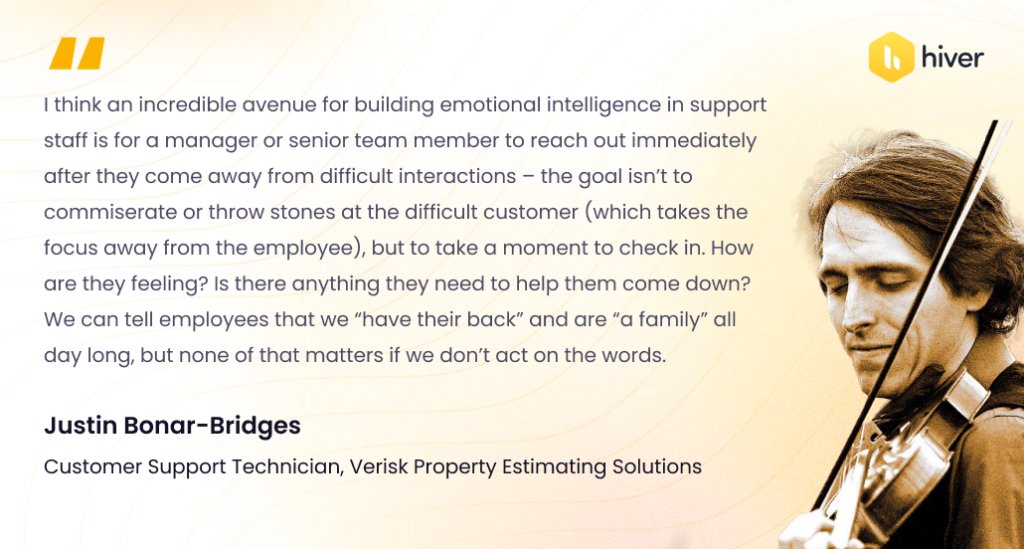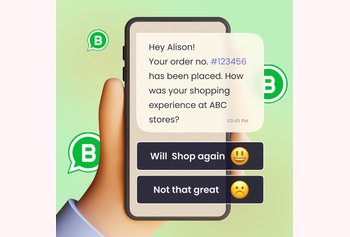Best Strategies for Managing Difficult Customer Conversations [Expert Opinion]

Table of contents
Conversations are at the heart of customer support, especially the tricky ones that really push the limits of patience and empathy.
Customer interactions aren’t just about helping them solve a problem. They’re moments that can either bolster or dent the perception of your brand. Also, the more challenging the interactions, the more it reveals about the skills of a support agent.
These high-stakes moments require not only a steady hand and a cool head but also a thoughtful approach, as agents navigate through the murky waters of misunderstandings, frustrations, and even confrontations.
In this article, I discuss the nuances of managing difficult conversations, with Justin Bonar-Bridges, a seasoned Customer Support Technician at Verisk Property Estimating Solutions (Xactware).
Justin stresses the importance of actively listening and validating the emotions behind a customer’s complaints. By responding in a way that acknowledges their feelings and guides them toward a resolution, he shows how these tough conversations can lead to significant growth in customer trust and loyalty. Let’s dive in further!
1. What strategies do you recommend for quickly identifying the root cause of a customer’s frustration or dissatisfaction?
For me the golden rule of all interactions is that there is a human being on the other side of the conversation and, as social animals, all human beings have an innate desire to be seen and heard. To that end, the single quickest way to identify the root cause of a customer’s frustration is to acknowledge their experience.
This means allowing them space to vent (most folks max out at about 30 seconds),repeating details back to both confirm information and let them know that you’re listening, and being attentive to their distress. When customers feel seen and heard they are more willing to work with you to pin down the issue, at which point we can ask more questions if necessary.
Keep in mind though that this isn’t a passive activity – we need to employ active listening skills and make a determined effort to understand the customer!

Maybe they’re using incorrect terminology that we have to decipher, or they mention something in passing that changes the entire context of their request. Maybe we’re on the phone with a customer whose word choice doesn’t reflect their frustration, but their heavy sighs or sharp tone suggests that something is simmering close to the surface. We need to be actively looking for clues that will determine if there’s more going on than what meets the eye!
2. How can customer support professionals effectively demonstrate empathy and active listening during challenging conversations?
The great thing about demonstrating empathy and active listening is that it works the same in all customer interactions! When the customer asks a question, answer it. When the customer provides information, thank them for it. When the customer expresses a concern or a frustration, acknowledge it. There is a natural rhythm to conversations, and those rules don’t change just because it’s a support interaction.

For example, let’s say you’re on the phone with a friend planning a lunch date later in the week. If they suddenly said, “It’s just been hard the last few weeks since my Grandmother died”, your response shouldn’t be, “So what dietary restrictions do you have?” Unfortunately, I see the equivalent in support interactions from time to time!
If the customer says, “I hope this works…my supervisor is on my case because everything is late now!”, a poor response would be, “I’m going to [task] now”, and a good response might look like, “I hear you! Let’s go ahead and [task] so that you can get that submitted as soon as possible!”
If the customer says, “Wait, are you sure I won’t lose my data? That’s months of hard work that I won’t be able to redo”, a poor response would be, “It’s safe, don’t worry”, and a good response might look like, “I understand! Let’s take a moment to make a quick backup just in case!”
3. What are some proven de-escalation techniques that can be used to calm an irate customer and steer the conversation toward a resolution?
At the risk of sounding like a broken record I’m going to start by reiterating the importance of the customer feeling seen and heard. Daniel Goleman, a famous psychologist who helped bring the idea of emotional intelligence to the mainstream, talks about a state of being where one’s emotions escalate to the point of overriding the rational part of the brain.
He calls it emotional hijacking, and as long as those emotions are running riot the rational brain cannot reassert itself. Hence, the goal is to help those explosive emotions subside so that the problem-solving part of the brain can take over.
Some of the ways we can help a customer feel seen and heard have been discussed already: restating the technical details of their situation for confirmation, acknowledging that their emotional response to the situation is valid, and giving them the space to let off some of their steam.
There’s another major technique we haven’t discussed yet though, which is apologizing.I get push back on this one from time to time, especially when my mentees are fresh off a difficult case and they themselves are frustrated or anxious. The thing that is easy to lose sight of is that apologizing doesn’t mean you agree with their assessment of the situation, and it doesn’t mean you excuse bad behavior.
It simply means that the situation has elevated the customer emotionally in a way that is detrimental. It isn’t, “I’m sorry you got mad.” (a classic non-apology),it’s, “I’m sorry that this has been such a frustrating issue.” Even if you’re struggling to not take the customer’s feelings personally, that second statement is easy to get behind!
And really, that’s the most important thing (and potentially most challenging based on the customer’s tone),whatever apology we proffer must be sincere! It’s easy to spot an insincere apology, even for the emotionally hijacked customer. We are trying to build trust, and being disingenuous in a moment where the customer is craving some amount of validation is a recipe for disaster.
Offering a sincere apology not only helps the customer feel seen and heard, but it establishes goodwill and, ultimately, can help the customer realize that we are both working towards a solution.
Everything you need to know about customer perception
4. How important is emotional intelligence in managing difficult customer conversations, and what steps can be taken to improve this skill within a support team?
Emotional intelligence is critical in difficult customer interactions, but not in the ways we often talk about in our field. The narrative around emotional intelligence is typically centered around heightening our ability to empathize with the customer. That’s massively important of course, because at the end of the day we’re humans working with humans. In difficult customer interactions, though, I think emotional intelligence is most important in how we relate to ourselves:
- Are we able to stay calm and grounded in the face of a belligerent customer?
- Can we depersonalize verbiage that is intended to be a personal attack?
- Can we recognize that we are a human being worthy of love and respect and that no matter what the customer says it isn’t truly personal?

Taking the time to actually press pause on customer interactions and make sure the technician knows the team has their back is a huge confidence boost, and can help that individual discover both what it feels like emotionally when they need help and that they can ask for it and receive it.
5. What kind of training and preparation is essential for support teams to handle difficult conversations confidently and effectively?
Let’s start with the preparation as it ties in directly with the prior question. Before our support teams are thrown into the deep end of the pool, it is vital that they understand what support they have themselves! What is the process for handing an irate customer off to a manager or senior team member? What systems are in place for agents to end interactions with abusive customers? The prospect of having to work one-on-one with someone who is aggressive, disrespectful, and/or combative can be intimidating; making sure team members know how they can navigate tense situations safely is critical.
As for customer support training, the empathy and active listening we’ve discussed already are obviously important. However, I’ve found when working with my mentees that they frequently don’t know what to say to acknowledge the customer’s emotions! It can be easy to get caught up in trying to gather casing details, determine troubleshooting steps, and lead with our problem-solving brain and then completely blank out when a customer expresses a feeling.
One thing I’ve recommended they do, to good effect according to CSAT improvements, is to reframe their role. If they make meeting the emotional needs of the customer their primary goal and meeting their technical/troubleshooting needs their secondary goal, then they no longer draw a blank when met with an emotional need.
My hypothesis is that it is difficult for a customer to truly assess the quality of the support they receive (because they generally aren’t experts in the field),so all they have to go on is how they feel about an interaction. If we fix a customer’s issue but they felt ignored, talked down to, or rushed, how do you think they’ll remember the interaction?
How much worse does that end up when it comes to difficult conversations? Now take those same interactions and regardless of whether or not the issue is resolved or not, imagine the customer feels acknowledged, cared for, and understood. Even customers coming away from difficult conversations that didn’t end with the resolution they’d hoped for will look back and feel like their concern was taken seriously (at least, that’s been my experience)!
6. After resolving a difficult conversation, what follow-up actions are critical to ensure customer satisfaction and prevent future issues?
The single most important follow-up action regardless of your product or business is to follow through on what you’ve promised! Remember, most difficult customers already feel on some level that there has been a breach of trust and that they weren’t provided with the experience that they expected.

- Did you promise to overnight a replacement to the customer? Do it!
- Did you promise partial reimbursement on a subscription or payment? Do it!
- Did you promise to call the customer back in a week to make sure their need is still being met? Do it!
We are trying to win back the trust of the customer, and betraying them in this critical moment is likely to push them away for good. Not only that, but a customer who feels they have been lied to is even more likely to communicate their dissatisfaction to others. In the age of social media, that can take on a life of its own and become the kind of viral attention that can cripple even the biggest of businesses!
Did you know: 72% of customers switch brands after just one negative experience.
7. How can technology, such as AI and CRM systems, aid in managing difficult customer conversations and improving overall customer experience?
I’ve been fortunate to pilot AI systems with my customers that generate chat responses, casing notes throughout the interaction, and step by step instructions based on knowledge base documentation. There would have been definite upsides to implementing these systems, but we didn’t move forward with any of them because, even with significant training, they all provided clunky text that could only work with what the customer provided.
That may be okay in situations where a customer needs something quick and simple (such as a password reset),but as we’ve talked about above, difficult customer interactions require genuine empathy, the ability to think critically about the customer’s verbiage to root out underlying emotions or requests, the ability to sincerely apologize, the ability to determine reasonable solutions that don’t over promise or waste the customer’s time, and, above all, the ability to see and hear the customer as a fellow human being.
Based on my experiences, machine learning isn’t close to providing that level of nuance yet and, even if it were, it can never provide the true human-to-human connection necessary for these interactions.
That said, I think there is still room for AI around these critical interactions – in the form of training. I’ve recently been testing out an AI training bot that could be used to help train support technicians on working with difficult customers.
Created by Power to the Brand (an early stage startup funded by Y Combinator),the bot simulates chat interactions with customers in a controlled environment where things like technician morale and brand loyalty aren’t at stake. Further, the level of cooperation and frustration of the bot customer can be tailored to meet the needs of the trainee. I think that using AI as a training tool like this leans into the strengths of machine learning and generative text without the dangers of misinforming customers or doing them the grave disservice of meeting their need for acknowledgment and validation with a tool that fundamentally lacks the ability to truly acknowledge or validate human feelings.
Conclusion
Justin Bonar-Bridges’ insights really drive home the importance of empathy, active listening, and sincerity when having customer interactions. By adopting these values, support teams can do more than just fix problems—they can cultivate lasting trust and loyalty with customers.
At Hiver, we take these principles to heart. Our tool is designed to help teams genuinely connect with customers. By using Hiver, support teams can ensure that every interaction is handled with care, making each customer feel truly valued. This approach doesn’t just resolve issues—it builds stronger, more meaningful relationships, reflecting our commitment to exceptional service.

































